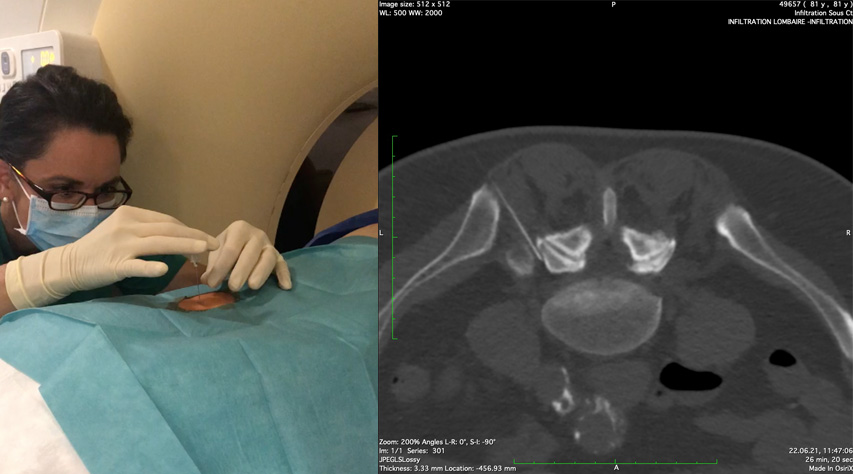
The purpose of an infiltration
The purpose of an infiltration is to inject a specific long-acting drug precisely into the area causing the pain, in a quick and painless way. After years of practice, we are convinced that this solution should be considered when conservative treatment proves ineffective.
In particular, this type of infiltration relieves sciatica – pain felt along one of the two sciatic nerves, at the back of the thigh – as well as cruralgia – lumbar pain radiating to the front of the thigh. These pains are usually caused by compression, inflammation or irritation of the nerve roots.
To help you familiarise yourself with this type of spinal infiltration, we explain what the procedure entails and provide information on the expected benefits.
Spinal infiltration: back pain, sciatica and cruralgia
Sciatica and cruralgia can be caused by different pathologies. However, more often than not, it is a problem with the disc that is the cause.
The foraminal route is preferred for lateral hernias.
The vertebral discs located between each vertebra play the role of shock absorber by protecting the spine from impacts. If posture is poor, then excessive use of these discs or physical exertion without adequate preparation can cause the disc annulus to become damaged and crack, thereby enabling a fragment of the disc to escape inside the nerve tunnel.
QWhat are the nerves causing these ailments?
The femoral nerve is a sensory-motor nerve in the lower limb. Sometimes, if it is weakened, irritated or inflamed, you may feel tingling, electric shocks or have difficulty moving one of your legs. But most often it is the sciatic nerve, the largest and longest nerve in the human body. The pain can manifest as burning, electric shocks, tingling, numbness or pain in the buttocks.
The mechanical blockage of one of these nerves can lead to a functional limitation of the lower limb and inflammation around the nerve root can cause a sharp pain.
What is a foraminal spinal infiltration?
The foraminal spinal infiltration consists of injecting a dose of corticosteroid as close as possible to the affected nerve roots. This type of infiltration is practiced to relieve persistent pain in the lower limb, when these cannot be relieved by traditional first-line treatments, such as physical rest, taking medication and physiotherapy.
Why perform this medical procedure in the radiology department?
The goal is to bring the drug’s active ingredient into immediate contact with the injured area. To achieve this, radiologists perform this procedure using a CT, also called computed tomography, CT-scan or CAT-scan. It is an X-ray device that enables the deeper parts of the body to be viewed from different angles.
Using images taken during the procedure, radiologists can view the position of the needle. This enables them to inject the product precisely into the affected area and increase the effectiveness of the procedure. In other words, the CT aims to guide the procedure with great precision.
How an epidural lumbar infiltration is performed under CT guidance
First of all, you will be taken care of by the medical imaging technician. They will direct you to the exam room and get you settled.
The radiologist will explain the procedure to you, then you will lie on your stomach. They prepare the equipment and disinfect the area to be treated and, with the help of the CT, will identify the location of the inflammation.
They will then direct a very fine needle towards the affected area and inject a small quantity of contrast medium to check that the position is correct.
Finally, they will administer the cortisone medication.
The procedure usually lasts approximately 20 minutes (preparation included). Following a short observation, you can return home but be careful not to strain the treated area.
What are the advantages of this infiltration?
You are advised to rest following the procedure. Typically, you will feel a positive effect about 10 days after the procedure.
Are there any risks and/or complications linked to an epidural infiltration in the lumbar region?
As with any injection, there is a very small risk of infection. At our medical imaging centre, we take all the necessary measures to rigorously and accurately sanitise the equipment and target region.
In terms of needle guidance, we apply the recommendations of the Swiss Society of Neuroradiology. Complications remain extremely rare.
You will be offered a safety questionnaire to prevent the risk of allergies or bleeding (taking certain medications and/or anticoagulants).
Learn more about foraminal spinal infiltration
If you would like more information on foraminal spinal infiltration or would like to make an appointment for an examination, do not hesitate to contact us.
Learn more about pudendal infiltration, extra-articular infiltration, osteoarticular infiltration, facet joint infiltrations, epidural lumbar infiltration or hyaluronic acid infiltrations.
Learn more about the other examinations available at the Medimage centre: radiography and radiology in Geneva, MRI in Geneva (Magnetic Resonance Imaging), CT scan, cardiac imaging, mammogram in Geneva, ultrasound in Geneva, elastography, biopsy in Geneva, infiltrations in Geneva, PRP infiltrations, dental panoramic or mineralometry.
Take a look at our medical team and our radiologists.
